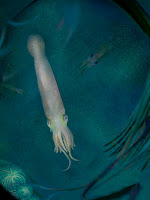 |
| Syllipsimopodi bideni Whalen & Landman, 2022 Reconstruction by K. Whalen. |
Abstract
We describe an exceptionally well-preserved vampyropod, Syllipsimopodi bideni gen. et sp. nov., from the Carboniferous (Mississippian) Bear Gulch Lagerstätte of Montana, USA. The specimen possesses a gladius and ten robust arms bearing biserial rows of suckers; it is the only known vampyropod to retain the ancestral ten-arm condition. Syllipsimopodi is the oldest definitive vampyropod and crown coleoid, pushing back the fossil record of this group by ~81.9 million years, corroborating molecular clock estimates. Using a Bayesian tip-dated phylogeny of fossil neocoleoid cephalopods, we demonstrate that Syllipsimopodi is the earliest-diverging known vampyropod. This strongly challenges the common hypothesis that vampyropods descended from a Triassic phragmoteuthid belemnoid. As early as the Mississippian, vampyropods were evidently characterized by the loss of the chambered phragmocone and primordial rostrum—traits retained in belemnoids and many extant decabrachians. A pair of arms may have been elongated, which when combined with the long gladius and terminal fins, indicates that the morphology of the earliest vampyropods superficially resembled extant squids.
Class: Cephalopoda Cuvier 1795
Subclass: Coleoidea Bather 1888
Clade: Vampyropoda von Boletzky 1992
Syllipsimopodi bideni gen. et sp. nov.
Holotype. ROMIP 64897 (Royal Ontario Museum).
Material. The type and only specimen was donated to the Royal Ontario Museum by B. Hawes in 1988; accession number 88-72717. There is no counterpart.
Locality. Bear Gulch Limestone, Heath Formation, Big Snowy Group, Fergus County, Montana, USA. The Bear Gulch Limestone is a plattenkalk, or lithographic limestone, similar to the more famous Jurassic Solnhofen Limestone of Germany. ...
Horizon. Bear Gulch Limestone, Arnsbergian E2b (~328.3–324.5 Ma), Serpukhovian (Namurian), Mississippian, Carboniferous8,18,32.
Diagnosis. Coleoid with simple, nearly triangular gladius, bearing funnel-like conus and median field with median rib, but no hyperbolar zones, cone flags, or lateral reinforcements; lateral fields unlikely. Lacking chambered phragmocone, primordial rostrum, or rostrum. Ten arms bearing biserial rows of suckers but no hooks or cirri; two arms may be elongated (though this could be taphonomic). Ink sac present. Terminal median fin support and one fin pair present.
Etymology. The genus name is derived from the Greek συλλήψιμος (syllípsimos) for prehensile and πόδι (pódi) for foot. The name prehensile-foot is chosen because this is the oldest known cephalopod to develop suckers, allowing the arms, which are modifications of the molluscan foot, to better grasp prey and other objects. The species name is to celebrate the recently inaugurated (at the time of submission) 46th President of the United States, Joseph R. Biden.
Christopher D. Whalen and Neil H. Landman. 2022. Fossil Coleoid Cephalopod from the Mississippian Bear Gulch Lagerstätte sheds light on early Vampyropod Evolution. Nature Communications. 13: 1107. DOI: 10.1038/s41467-022-28333-5
Octopus Ancestors Had 10 Arms, New Study Shows









